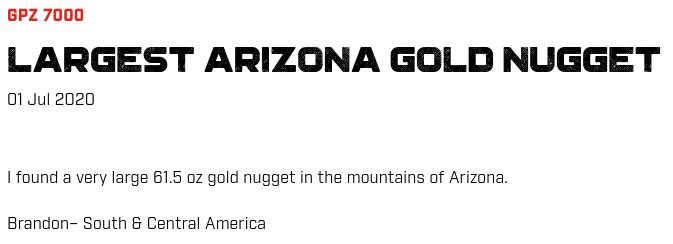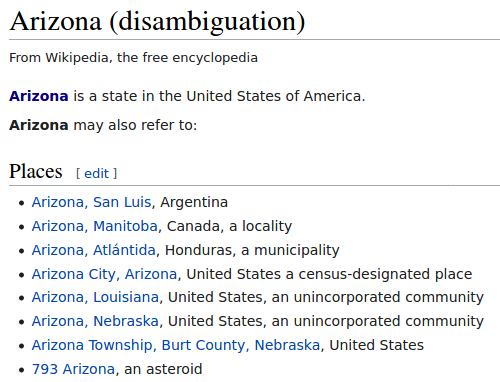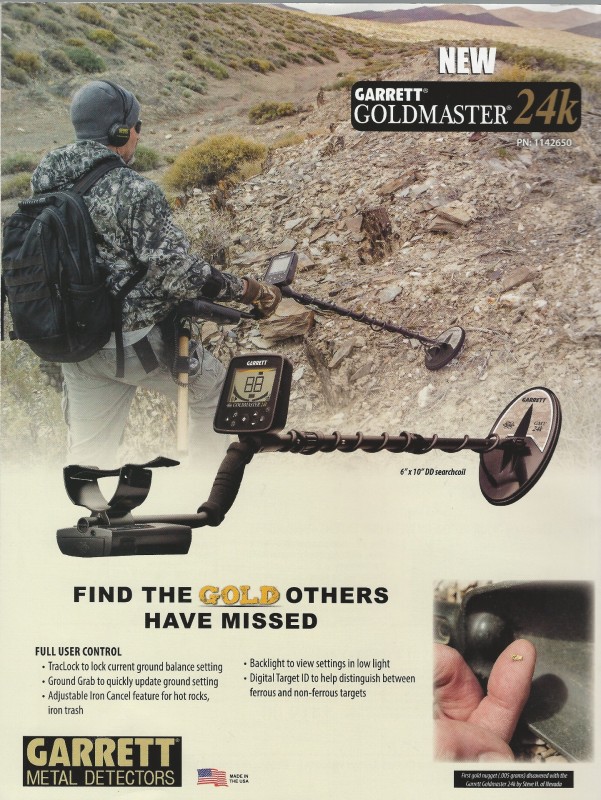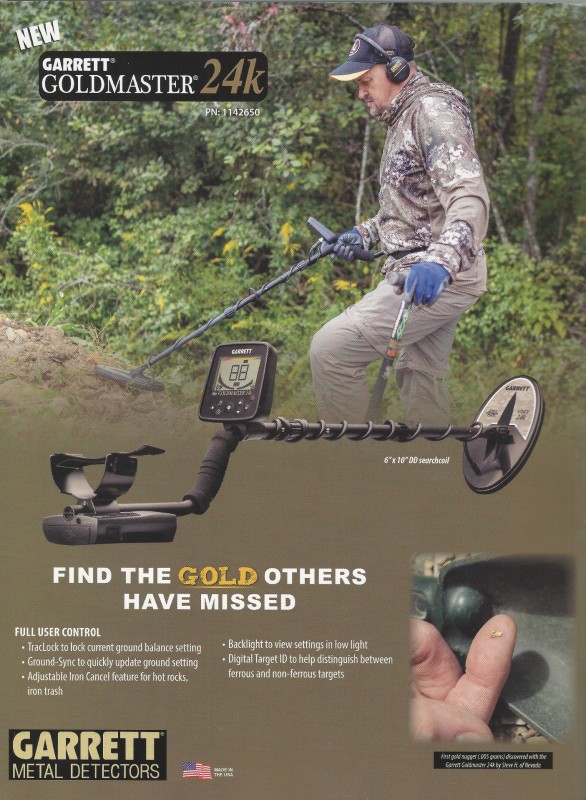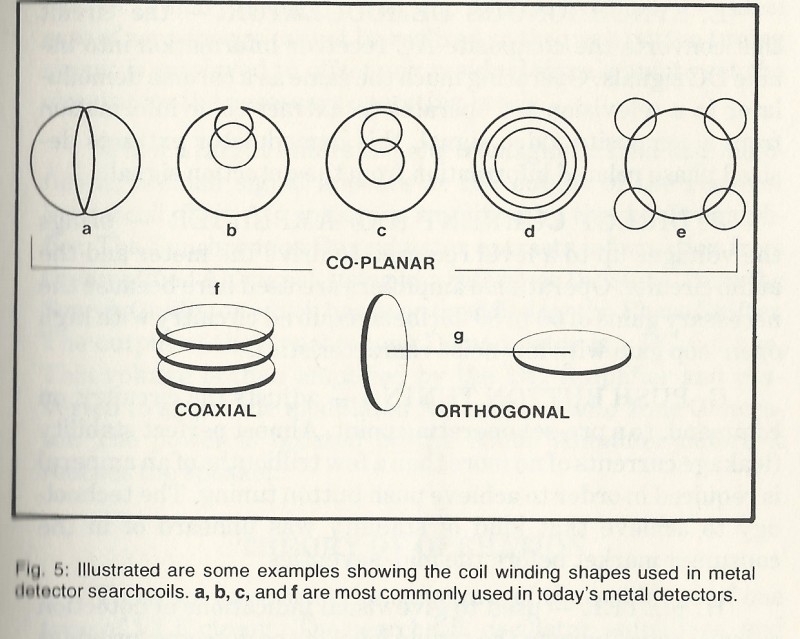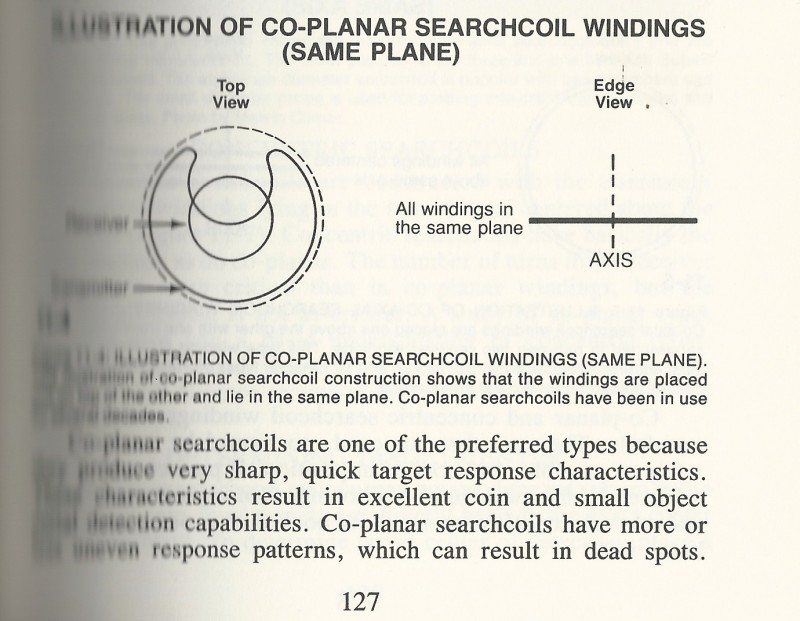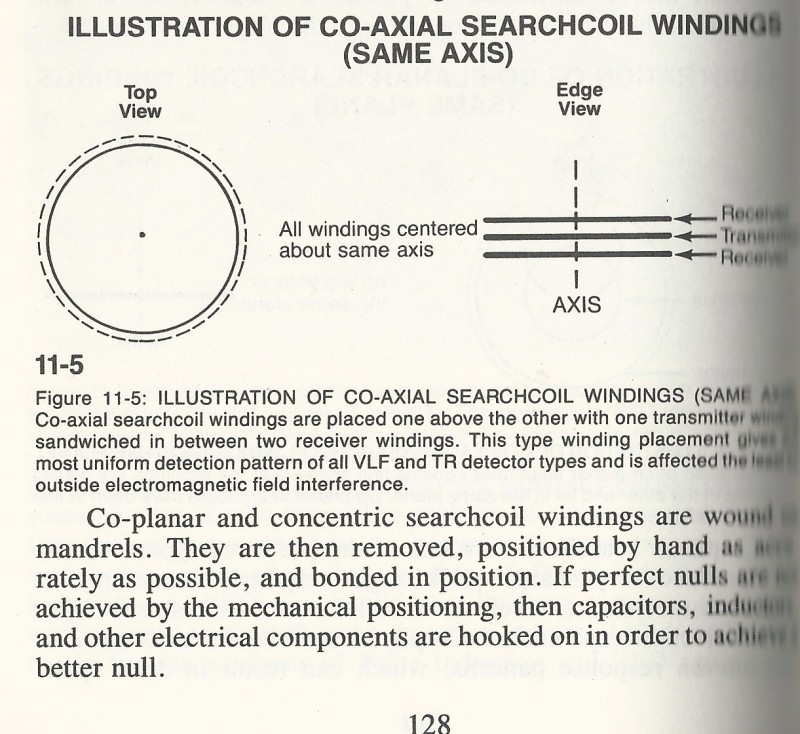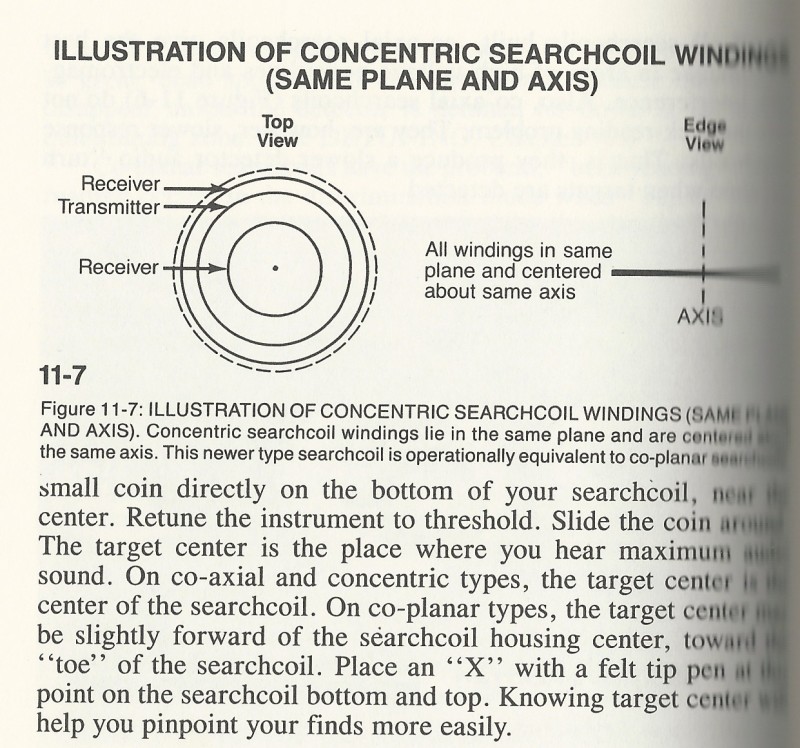-
Posts
5,808 -
Joined
-
Last visited
Content Type
Forums
Detector Prospector Home
Detector Database
Downloads
Everything posted by GB_Amateur
-

First Impressions Of The Deus II
GB_Amateur replied to Erik Oostra's topic in Metal Detector Advice & Comparisons
You haven't gotten answers from owners (or Chase...) so I'll answer from what I've read. "No." The 12 stock modes can be changed during a hunt but once you turn it off, they revert to default. However, there are 12 user memory slots/modes which you can initialize with a stock program, make your changes (you may have to push a 'save' button -- don't remember) and those will be kept in memory whether or not you turn the detector off. You have to guess??????? Rule #1: When in doubt, read the manual. Rule #2: Even with no doubt, read the manual! Rule #3: Skip Rule #1 and proceed to Rule #2. -
I'd say you've done a good investigation. Specific gravity test on the original chunk (probably too late for that...) and on one of the purest pieces would likely shed some light. Conductivity test with an ohm-meter (multimeter) is another easy test. If you had a PI with adjustable delay, that might tell you something. But it's hard to beat an XRF spectrum when done by a competent technician. If you had more of it, an assay would make sense, of course, but I doubt that is cost effective for one piece. 50k(?) question: can you go back for more?
-
Another example of "great minds think alike"? 😁 I've spent the better part of the last several days recording Equinox dTID's on the bench, mostly with the Wheat cent series (50 years x 3 mints, with some missing teeth). I also measured some IHP's, but only about 30 of those. These have been done with undug coins. I have done some spot checking as well with dug cents (14 IHP's and about a similar number of Wheaties) to see if being in the ground for decades makes a difference. There are some surprises. (Well, at least some of the results surprised me.) I should be writing that up tomorrow. I'm glad others are interested. I've never heard of 5 cent 'nickel' variations other than for some select dug Wartime (1942-45) 35% silver, 9% manganese versions. You're talking about 75% Cu, 25% Ni (standard composition) variations in dTID's??
-

World Class Arizona Nugget Recent Find
GB_Amateur replied to Gerry in Idaho's topic in Detector Prospector Forum
Simon, you need to read the fine print! Just like searching for gold, go to the source. (Seems we are veering further off-topic....) -
Are these analogies helpful (although inexact)? a) Four wheel drive or two wheel drive? b) Two eyes or one; two ears or one? c) Suppose you could outfit a headgear for night vision -- one eye views visible light through high collection efficient optic, the other eye similarly outfitted but viewing in the infrared. Modern multifrequency IB/VLF is more complicated than these, but the principle is the same -- collecting information through two (or more) different viewpoints effectively provides more information. At least that's my limited, simplified understanding of what's going on. How that information is handled in software -- I think that is where improvements have been made recently and hopefully will continue to be made.
-

World Class Arizona Nugget Recent Find
GB_Amateur replied to Gerry in Idaho's topic in Detector Prospector Forum
If you go to the Minelab page that Lunk linked in his post you can see a much higher resolution picture which you should be able to zoom in on. -
Which ones are you referring to, CTX and ?? Effectively the Equinox has replaced the CTX, maybe not in absolute performance, but when you fold in value. They lowered the price bar while more/less keeping the performance, and although XP is trying to raise it, a CTX (current) price point is going to require one helluva new detector, IMO. After jumping out of an airplane with the Eqx four years ago, they're going to have to arrive in a Branson/Bezos/Musk level vehicle in the next Detectival unveiling. 😏
-
Welcome, Gary! Sounds like you have a lot of experience and knowledge. I look forward to you sharing those (and I just saw one post where you've started). "Treasure Coast," "since the 70's," I'm already getting excited anticipating stories you can tell.
-
Welcome, Dave! Summit County for sure, with over 1,000,000 ounces mined prior to 1960, almost 3/4 of that placer (see p. 116 of https://pubs.er.usgs.gov/publication/pp610). Hope you can find some unclaimed federal land (or private property with permission) to try your skills at gold detecting with that new detector, once the snow melts.
-

World Class Arizona Nugget Recent Find
GB_Amateur replied to Gerry in Idaho's topic in Detector Prospector Forum
Hmmm. Minelab page says (and noting in particular where the finder hails from): Wikipedia says: Makes me wonder if he's in one of those other Arizonas. Also, note the date on the Minelab report -- 1 1/2 years ago? -
42 gold rings in 6 months? Heck, 42 gold rings in six years sounds like an over-the-top success (for many of us)! 188 silvers is almost 5 times what I found, but my rationalization is that mine are in better condition. 😁 Lots of variables in detecting opportunities but hopefully 2022 won't bring anything close to as bad as what you saw in 2021. Besides your upcoming finds, I'll be interested in seeing how long you hold out on getting a Deus II.
-

My Cheeks Were Rosie
GB_Amateur replied to Againstmywill's topic in Metal Detecting For Coins & Relics
Back when they still used coins in LV slot machines I used to play with nickels I had already searched and then keep the payouts separately to search them (for dates+mm). The faces of the coins definitely showed scratches, although I don't think they were as bad as that dime. It looks like it's been dragged across a paved parking lot. As far as a USA quarter getting its reeded edge worn away in a slot machine -- that seems like a longshot (pun intended). -

World Class Arizona Nugget Recent Find
GB_Amateur replied to Gerry in Idaho's topic in Detector Prospector Forum
What's the current record for largest nugget ever (recorded) found in AZ? Ever found with a metal detector? -
Paying a bit extra for a digital target ID readout detector makes sense for someone who has a chance of staying with the hobby. Many people who buy Christmas and birthday gifts are very much into cost, not value. They might even think "so-and-so isn't going to stay with this anyway so why should I spend one extra dollar..." As far as a better featured detector leading beginning detectorists respect the land, though.... We park, school, beach detectorists have a more/less similar historical experience to compare to -- the aluminum can pulltab. Early on (1965-75) those weren't attached to the can so it was easy to toss them aside. There was already an advertising campaign here in the USA regarding littering. That didn't work (or at least not well enough). So the can industry was forced to try something different -- the 'square tab' (and eventually 'racetrack tab', 'modern tab') still in use today. The other component of that design was a (small) coin-sized flap that was pushed into the can. Surely these changes would solve the problem. And the cans themselves? At least the people who cut the grass will pick them up before mowing. What you propose makes sense, but only for people who have sense -- a sense of responsibility.
-
Well, I should have dug a bit deeper. On the Garrett webpage for the 24K there are a handful of videos by none other than @Steve Herschbachhimself. I just clicked on one and watched a minute or so and not surprisingly (i.e. representative of the 'actor') the information is of high quality. Gold Prospectors Magazine is a bimonthly hardcopy publication of the GPAA. Garrett has a 40+ year history of posting ads on the back cover of the appropriate magazines. Here are those from the latest two from this magazine: Looks like George Wyant (aka 'King George') in the second one. Maybe that's Steve's finger in the lower RH corner of each?? At least he photoed his index finger. No subliminal messaging....
- 32 replies
-
- minelab gold monster
- 24k gmx
-
(and 1 more)
Tagged with:
-

Henry 3 Gold Penny Found
GB_Amateur replied to Steve Herschbach's topic in Metal Detecting For Coins & Relics
Exceded the high end of the pre-auction estimated range by 35%. That's a nice chunk of change. -
I'm including some illustrations to help understand the construction (not necessarily the operation) of the different types of IB searchcoils. First is general, from Lagal and Garrett p. 27 (1979) and note that DD (labeled a) is a specified there are a type of co-planar as is the concentric (d). Later illustrations below go into some more detail but DD isn't covered: Next three are from Garrett pp. 127, 128, 130 (1985). I've typed in the figure captions since they didn't scan well: Figure 11-4: ILLUSTRATION OF CO-PLANAR SEARCHCOIL WINDINGS (SAME PLANE). This illustration of co-planar searchcoil construction shows that the windings are placed one on top of the other and lie in the same plane. Co-planar searchoils have been in use for several decades. (Note: inner circular coils is labeled 'Receiver' and outer coil is 'Transmitter'.) Figure 11-5: ILLUSTRATION OF CO-AXIAL SEARCHCOIL WINDINGS (SAME AXIS). Co-axial searchcoil windings are placed one above the other with one transmitter winding sancwiched in between two reciever windings. This type winding placement gives the most uniform detection pattern of all VLF and TR detector types and is affected the least by outside electromagnetic field interference. Figure 11-7: ILLUSTRATION OF CONCENTRIC SEARCHCOIL WINDINGS (SAME PLANE AND AXIS). Concetnric searchoil windings lie in the same plane and are centered about the same axis. This newer type searchcoil is operationally equivelent to co-planar serachcoils. Here are some details from the text in chapter 11 which may give some details of advantages/disadvantages of different types: (p. 127): Co-planar searchcoils are one of the preferred types because they produce very sharp, quick target response characteristics. These characteristics result in excellent coin and small object metal detection capabilities. (p 129): ...Co-axial searchcoils give the best performance in areas of high voltage powerlines and electromagnetic interference. (cut a sentence) They are, however, slower response searchcoils. That is, they produce a slower detector audio "turn on" time when targets are detected.
-
Ah, thanks for repeating that. I just checked a wound up (not like a coil, though) piece of the ~2.0 mm version. (You didn't expect me to just take your word for it, did ya? 😁) I didn't measure the lenght but guessing 2-3 ft. It was right at 14-15. So the signal strength increases but the dTID stays the same. Good to know; I'll try and remember better than I read. 😏
-
I wonder if they really know the 'value' they have in that detector. I remember (hopefully clearly...) back in the mid-late 70's. White's was advertising their 5 kHz Deepseeker (also called 'Master Hunter') VLF as the gold detector and their 15 kHz Groundhog (in the 80's called 'Gold Hunter') as a coin detector! Now that Steve has pointed out the relationship between target size and optimal frequency, maybe they were effectively pushing the 5 kHz model because it sounded off well on large gold (which was more available then, although not plentiful). Anyway, within about a 5 year period the roles flip-flopped. I think at least part of the reason for the change-of-heart was the success the 15 kHz Groundhog had in Australia. That was mostly Charles Garrett back then, with his pal Roy Lagal as advisor and now they're gone. But who at Garrett (or who among their supported field crews) is a true native gold detectorist? They have plenty of coin and relic hounds -- see the plethora of videos. They had some of the Gold Rush TV show cast (yeh, Todd Hoffman hawking your products -- how wise is that?) using their pans and I remember a YouTube video where Freddy Dodge swung an ATX, but I think he admitted he hadn't done much detecting. I recall the Ace Apex pre-release video by an Aussie but he was finding coins. Maybe he is their authority on native gold detecting? Simon, IMO you can be their expert gold detectorist spokesperson. The least they would do is fly you over some (free) gear, like a hat and finds pouch.
- 32 replies
-
- minelab gold monster
- 24k gmx
-
(and 1 more)
Tagged with:
-
Got my Equinox set up on the bench for some coin dTID testing so I grabbed three pieces of (dug) scrap copper wire, each about 3 inches or so in length but in various orientations (~2.0 mm dia. w/hook half loop on one end, ~2.2 mm dia. straight, ~3.2 mm dia. L-shape). The dTID readings on the Eqx were a bit broad but approximately 14-15, 15-16, and 18-20 respectively in Park 1, recovery speed = 4, gain = 17, 11" coil. Targets were swiped about 2.5-3.5 inch above the center of the coil. (For reference, our USA 5 cent hits 12-13 and our modern zinc cents around 21, if uncorroded/undamaged.) So maybe those numbers are more in line with what you expect? The lengths of copper wire I find can be all over the place, from half inch to a couple feet. Not surprisingly the in-field dTID's vary with length and shape, too.
-

Garrett 24k Wireless Bluetooth Audio
GB_Amateur replied to GotAU?'s topic in Garrett Metal Detectors
I assume you are referring to this. (...aptX LL/FS 40 ms...) -
Seemingly lost in all this is the fact that this detector was released 3 1/2 years ago (Sept-Oct 2018, right?) by White's, and (AFAIK) it's the same detector now that Garrett is selling it. I realize there has been occasional praise (Steve H. for example) in that time period, but for the most part it seems like a secret. Apparently White's demise (although that was well over a year after its release) and the detector's disappearance from the market for ~2 years explains it some. Throw in the fact that it's a specialty detector. An apples to apples comparison is the ML Gold Monster 1000. Was that so calmly released and received? Still, with all the hubub we're hearing now for the XP Deus II (and don't forget the pre-release frenzy of the ML Equinox), I'm surprised it's taken so long for this to get exposed. I blame you, Simon.
- 32 replies
-
- minelab gold monster
- 24k gmx
-
(and 1 more)
Tagged with:
-
It's not that difficult to answer this kind of question before strarting a false rumor. Their website appears to be up-to-date. I count six detectors in the $299-$849 price range still in their lineup. There are a couple cheaper children's detectors and the considerably more expensive computer imaging models and Ground Penentrating Radar (GPR) hybrids also shown there: https://www.noktadetectors.com/metal-detectors/
-
I find quite a bit of copper wire -- single stranded (but not coiled) used in constuction. I think the gauge is in the 12-16 range. They typically hit in the USA zinc penny and aluminum screw cap range. IMO, an iron alloy nail oriented with its axis parallel the coil's axis (think vertical when in the ground) can give an interesting positive response. Certainly the nail head contributes, but even nails without heads seem to show similar results. My hypothesis is that what is effectively happening is similar to a stack of small discs which add constructively. Do you have a different hypothesis for that apparent phenomenon (or am I just imagining this genearlization)? Possibly I'm assigning a conductive explanation to a ferromagnetic property....


